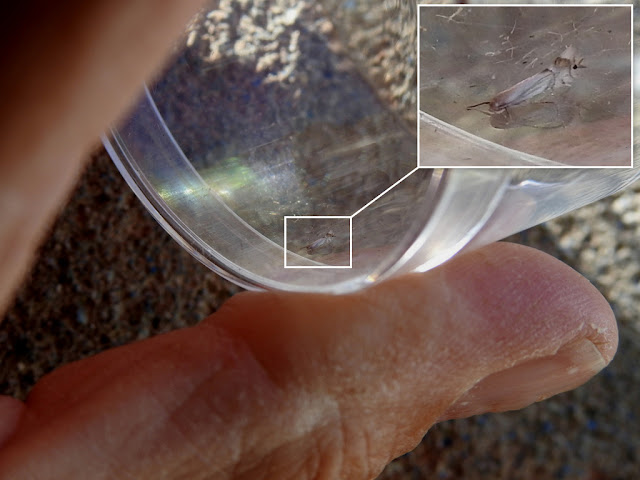The moth list hit 140 today. Many keen moth-ers have garden lists running into
several hundreds, so I've barely scratched the surface yet. Even so, that's
140 [mostly] new names to learn, plus the ability to match them to actual
moths. Boy, it's hard. Especially tricky are the scientific names which come
with most micro-moths. I don't know when I last needed to learn so much new
stuff so quickly.
Photography has helped, especially with the micros. By taking photos, then
labelling them, I am hoping the process of simple repetition will make some of it stick.
This has presented new challenges though. While it's easy enough to photograph
a Privet Hawk-moth 60mm long, some of the micros have been 5mm or less
- 3.5mm is the smallest so far - and those tiny ones are very difficult to
capture well with the P900. But it has been fun trying...

|
Phyllocnistis saligna (Willow Bent-wing) makes an
appearance in my state-of-the-art macro-photography studio, complete
with some old bloke's knackered-looking thumb.
|
Getting the lighting right has been the most challenging aspect really. A soft
light, yet bright enough to let the camera operate on a setting that will give
minimal pixellation, is what I'm after, but too often I get more contrast than
I want. Slowly improving though, I think. A few favourites from the last
couple of days...

|
Shades of grey. Sycamore (left) with a Dark or
Grey Dagger. The latter are [externally] inseperable as adults,
though their caterpillars are chalk and cheese.
|

|
Sexually dimorphic, so I know that this is a female. If all my photos of
8mm moths came out this well, I would be very pleased indeed.
|

|
The ID of this 6mm moth is probably a bit sketchy, as there are
look-alikes. However, I have plumped for the commonest probable.
|

|
A new pug this morning. Woo-hoo! It made me very happy.
|

|
This is our third Small Elephant Hawk-moth, and a bit less than
pristine. Not sure why I didn't photograph the first two, because they
are absolutely gorgeous.
|

|
One of the millions of 'bird poo' moths.
|
As far as I can tell, the miniscule speck in the first photo is probably the
scarcest of this lot, and may even be a first for Bridport. Certainly it is
the least recorded anyway. And I'm not surprised. Even those with eyesight
sharp enough to see the thing would be hard-pressed to recognise the flicking,
silvery speck as an actual moth...

|
Those scattered 'hairs' are from a previous shaggy occupant of this pot,
in other words a normal-sized moth.
|
Somewhere in those photos above (Coleophora lutipennella) I allude to my occasional 'less than certain' identifications. I have
learned very quickly that moth ID is frequently art as much as science. Sure,
you can dissect the things and examine their reproductive organs...but I have
no intention of wandering that far down the Dark Path. Which means I have to
rely on what is externally visible and do the best I can. This is fun, and a
near-future post will be entitled 'Moth ID - First Impressions', or something
similar. And it is definitely better than gulls.
Or worse.









Good images Gavin. There is a bit of software, Photoscape X, that might help with contrast etc. It's a free download, doesn't do anything weird to your computer and is pretty straightforward to use. I tend to use a one click sharpen and then in the colour menu I can doodle with the contrast, vibrancy etc. Maybe you use Adobe or such-like already but if not I find this effective. I think you've already surpassed my garden list, from 12 years of mothing, if not, not far off. But 12 years on I'm still catching new stuff fairly regularly, and still struggle with identification, as you've seen!
ReplyDeleteThanks Alistair, appreciate the recommendation. I have used Picasa for years, but lately also FastStone. The latter is free, easy to use, and 'lightweight', in that it operates quickly on my elderly laptop and doesn't tie it in knots. Mostly they do what I need, and any shortcomings are likely down to my camera and my skills, or rather, lack of...
DeleteI probably don't appreciate how richly endowed with moths Dorset is. And certainly I didn't realise how relatively few species there might be in some locations! Good to hear that you're still getting new ones though. Thanks again for your comment. 😊👍